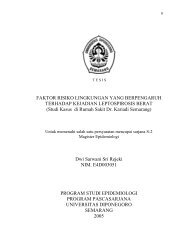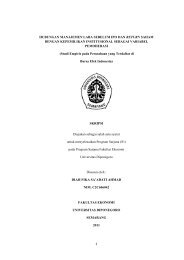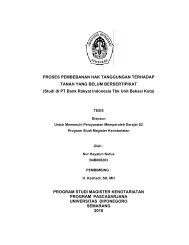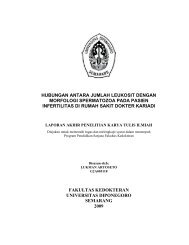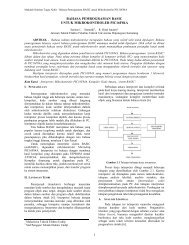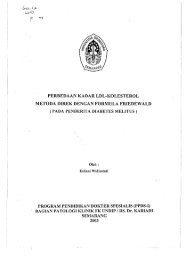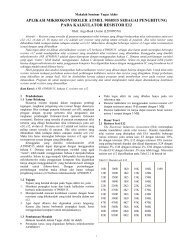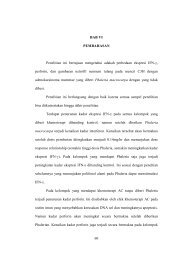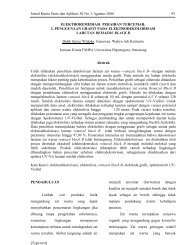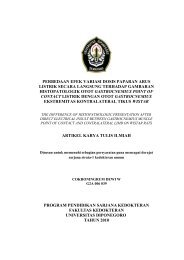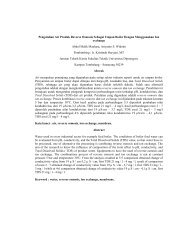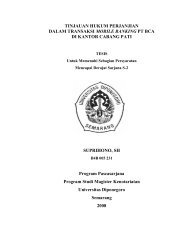Organizing Knowledge in Implementation of Knowledge ...
Organizing Knowledge in Implementation of Knowledge ...
Organizing Knowledge in Implementation of Knowledge ...
Create successful ePaper yourself
Turn your PDF publications into a flip-book with our unique Google optimized e-Paper software.
Proceed<strong>in</strong>gs <strong>of</strong> The 1 st International Conference on Information Systems For Bus<strong>in</strong>ess Competitiveness (ICISBC) 2011<br />
strategy to change the organization's <strong>in</strong>tellectual assets,<br />
whether the <strong>in</strong>formation is already recorded and talents <strong>of</strong> its<br />
members <strong>in</strong>to higher productivity, new values, and <strong>in</strong>creased<br />
competitiveness . In l<strong>in</strong>e with the op<strong>in</strong>ion <strong>of</strong> KTI, The<br />
American Productivity and Quality Centre (TAPQC) def<strong>in</strong>es<br />
knowledge management as "the strategy and the process <strong>of</strong><br />
identify<strong>in</strong>g, captur<strong>in</strong>g, and leverag<strong>in</strong>g knowledge to enhance<br />
competitiveness.<br />
Organizations should <strong>in</strong>hibit replication <strong>of</strong> its<br />
superior performance by runn<strong>in</strong>g a strategy that competitors<br />
have a high uncerta<strong>in</strong>ty about what should be replicated and<br />
how its application. The argument based on sources for<br />
susta<strong>in</strong>able competitive advantage and performance have<br />
focused on organization-specific assets <strong>of</strong> value, rare,<br />
difficult to imitate, and difficult substituted (Barney <strong>in</strong><br />
Simon<strong>in</strong>, 1997). <strong>Knowledge</strong> arises as a significant source <strong>of</strong><br />
the organization's most strategic and organizational ability to<br />
learn faster than competitors as a form <strong>of</strong> susta<strong>in</strong>able<br />
competitive advantage (DeGeus <strong>in</strong> Jashapara, 2003:31-50).<br />
Drucker (1988:45-53) states that the type <strong>of</strong> organization is<br />
now based on the <strong>in</strong>formation. Schulz (2001:661-668) also<br />
suggests that the organization's ma<strong>in</strong> challenge now is to<br />
produce and process knowledge. It can be concluded that the<br />
knowledge ga<strong>in</strong>ed from the learn<strong>in</strong>g process is a form <strong>of</strong><br />
appropriate strategies that should be owned by the<br />
organization <strong>in</strong> the era <strong>of</strong> competition. Advantage based on<br />
this knowledge valuable, rare, difficult to imitate, and<br />
difficult to be substituted by competitors.<br />
Leonard and Sensiper argued that the statement<br />
taken from the assumption <strong>of</strong> Polanyi (1967) <strong>in</strong> Simon<br />
(1991:126) which states that all knowledge has a tacit<br />
dimension. Berman et al. proposed two types <strong>of</strong> tacit<br />
knowledge: "Tacit knowledge <strong>of</strong> <strong>in</strong>dividuals (Individual<br />
tacit knowledge) At the <strong>in</strong>dividual level, the concept <strong>of</strong> tacit<br />
knowledge is closely related to the concept <strong>of</strong> skills /<br />
expertise (Nelson & W<strong>in</strong>ter, 1982; Polanyi, 1969). Include<br />
pattern recognition acquired through cumulative experience,<br />
which is done with the background is not realized, it is<br />
difficult articulated, and form the basis <strong>of</strong> <strong>in</strong>dividual<br />
expertise is valuable. Tacit knowledge-based team (Team<br />
based tacit knowledge) Weick and Roberts (1993:357-381)<br />
argues that the knowledge associated with the group's<br />
activities are stored <strong>in</strong> someth<strong>in</strong>g called "collective m<strong>in</strong>d."<br />
<strong>Knowledge</strong> is def<strong>in</strong>ed as a comb<strong>in</strong>ation <strong>of</strong> group or<br />
<strong>in</strong>dividual cognitive patterns obta<strong>in</strong>ed through shared<br />
experiences and expressed through action synchronization is<br />
not realized when the group faced with complex tasks that<br />
must be done <strong>in</strong> the context <strong>of</strong> environmental challenges.<br />
"(Berman et al. 2002:13)<br />
<strong>Knowledge</strong> management systems provide the right<br />
<strong>in</strong>formation to the right people at the right time, and<br />
provides a tool - a tool for analyz<strong>in</strong>g that <strong>in</strong>formation, as<br />
well as provid<strong>in</strong>g power responsive to the <strong>in</strong>spiration they<br />
get from the <strong>in</strong>formation obta<strong>in</strong>ed <strong>in</strong> the time and everyth<strong>in</strong>g<br />
as fast as lightn<strong>in</strong>g. (Jerry Honeycutt, 2000).<br />
Components <strong>of</strong> Information Technology <strong>in</strong> <strong>Knowledge</strong><br />
Management. Application <strong>of</strong> appropriate technology could<br />
enable the technology becomes a strategic property. The use<br />
<strong>of</strong> <strong>in</strong>formation technology as a strategic asset <strong>in</strong> design<strong>in</strong>g<br />
and manag<strong>in</strong>g organizations can make the organization more<br />
responsive, flexible and efficient, or even an organization <strong>in</strong><br />
the <strong>of</strong>fensive position. However, this application is not<br />
always successful. Errors <strong>in</strong> the implications and concepts<br />
can lead to failure <strong>in</strong> adopt<strong>in</strong>g <strong>in</strong>formation technology.<br />
Problems associated with plann<strong>in</strong>g and implementation <strong>of</strong><br />
<strong>in</strong>formation technology should get serious consideration by<br />
management, it is <strong>in</strong>tended to obta<strong>in</strong> <strong>in</strong>formation <strong>in</strong> a short<br />
time. As noted by Jann Tjakraatmadja Hidayat <strong>in</strong> the book<br />
"<strong>Knowledge</strong> Management" that,"The development <strong>of</strong><br />
Information Technology has <strong>in</strong>creased the productivity <strong>of</strong><br />
knowledge discovery (ease the process <strong>of</strong> knowledge<br />
management) as well as accelerate the implementation<br />
process, thus allow<strong>in</strong>g organizations to<br />
meng<strong>in</strong>stitusionalisasikan and distribute knowledge derived<br />
from the <strong>in</strong>dividual - the <strong>in</strong>dividual members <strong>of</strong> the<br />
organization <strong>in</strong> accordance with the needs and<br />
development." (Tjakraatmadja, 2006:143 - 144)<br />
IT developments also have a tendency to keep<br />
chang<strong>in</strong>g every time. This trend is divided <strong>in</strong>to three stages,<br />
namely the era <strong>of</strong> data process<strong>in</strong>g (data process<strong>in</strong>g), the era<br />
<strong>of</strong> micro-, and the era <strong>of</strong> the network (network) between<br />
each era lasted 15 to 20 years (Nolan (1995) <strong>in</strong> Indriantoro,<br />
1996:79). This development <strong>in</strong>dicates that <strong>in</strong>formation<br />
technology is constantly chang<strong>in</strong>g. The trend <strong>of</strong> hardware<br />
cont<strong>in</strong>ues to <strong>in</strong>tegrate with the development <strong>of</strong> the world as<br />
a whole. develops characterized by size (size) is gett<strong>in</strong>g<br />
smaller, the velocity (speed) is higher, the storage capacity<br />
(storage capacity) is the greater, durability (reliability) is<br />
gett<strong>in</strong>g stronger, the cost (cost) are gett<strong>in</strong>g cheaper, and<br />
options (options ) are more and more. The trend is also<br />
develop<strong>in</strong>g computer s<strong>of</strong>tware marked with easy<br />
programm<strong>in</strong>g and many programs are used (s<strong>of</strong>tware<br />
package). Trends <strong>in</strong> telecommunications also developed<br />
along with the development <strong>of</strong> <strong>in</strong>formation technology. The<br />
most significant developments <strong>in</strong> this trend is digital<br />
technology, optical fiber transmission, wireless<br />
telecommunications, and network <strong>in</strong>telligence. The third<br />
trend has been mak<strong>in</strong>g IT as an <strong>in</strong>tegral part <strong>of</strong><br />
organizational life, especially large-scale organizations.<br />
Suadi (1993:39) and Sudibyo (1992:25) states that<br />
the impact <strong>of</strong> <strong>in</strong>formation technology on organizations,<br />
users, and men supporters, among others, is to <strong>in</strong>crease the<br />
efficiency <strong>of</strong> operations, support strategic <strong>in</strong>itiatives, expand<br />
the boundaries <strong>of</strong> the organization, chang<strong>in</strong>g work patterns,<br />
chang<strong>in</strong>g the terms <strong>of</strong> the ability <strong>of</strong> <strong>in</strong>dividuals <strong>in</strong><br />
organization, change the nature <strong>of</strong> supervision, improve<br />
competitiveness, and seek the appropriate cultural platform.<br />
Farrel and Song (1988:10-16) proposes four areas <strong>of</strong><br />
<strong>in</strong>formation technology applications, namely: <strong>in</strong>ternal<br />
operations, bus<strong>in</strong>ess units, organizational boundaries, and<br />
new products. First, the <strong>in</strong>ternal operation. In this field, <strong>in</strong><br />
348



